Both the Yokohama Geolandar AT G105 and the Bridgestone Dueler AT Revo 3 are all terrain tires, which are more on road oriented than off road. This means that even though they are capable of going on rougher tracks, they can not take on challenging off road terrains. But on pavements, these tires are silky smooth.
The Yokohama AT is famous for it’s comfortable on road ride and snow performance (earning 3PMSFR), while the Bridgestone Dueler is very gripping on dry road during braking and turning. Let’s check out both of these tires in detail.
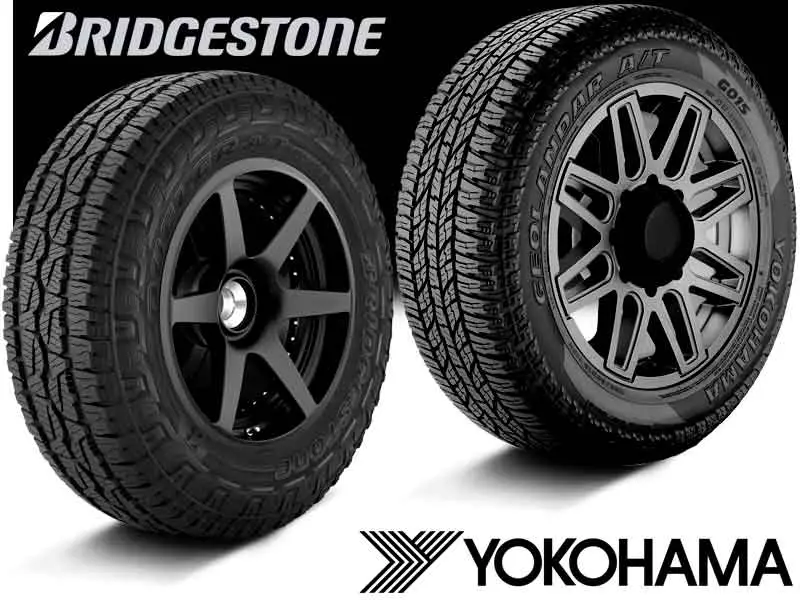
Table of Contents
Tread Design
Let’s start with sizes and overall construction of both tires.
Overall, the Geolandar AT is available in more sizes, and has larger load and speed ratings in comparison, so it makes sense why it’s weight range is also greater.
| Bridgestone AT Revo 3 | Yokohama Geolandar G015 | |
| Available sizes | 16″ to 20″ | 15″ to 22″ |
| Load Range | SL, C, E | SL, XL, C, D, E |
| Speed Rating | R, S, T | R, S, H |
| Weight Range | 30 to 54 lbs | 27 to 70 lbs |
| Tread Depth Range | 12, 14, 15, 16, 17/32″ | 11, 12, 13, 17, 18/32″ |
| Sidewall Construction | 2 ply | 2 ply |
Yokohama G015 AT
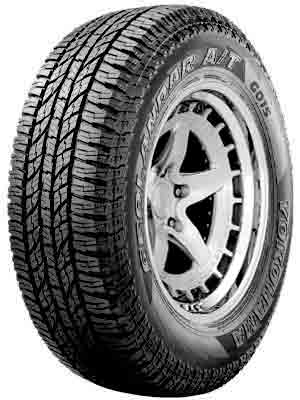
Bridgestone Dueler AT Revo 3
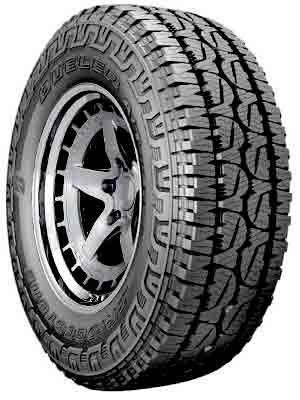
Starting with one of the most comfortable tires you can get your hands on, the Yokohama Geolandar AT G105 offers 3 main ribs in the middle, where the central most is continuous, meaning it does not make proper lateral grooves in between, as they are joined together by a rubber rib underneath.

Same is the case with the outer two ribs, they also have dual compound as all blocks here are also joined together with another layer underneath. This provides this tire with directional stability (for the most part).
On the other side, here the central part is made up of 2 ribs only where both carry similar looking blocks (but inverted to create aggressive biting).
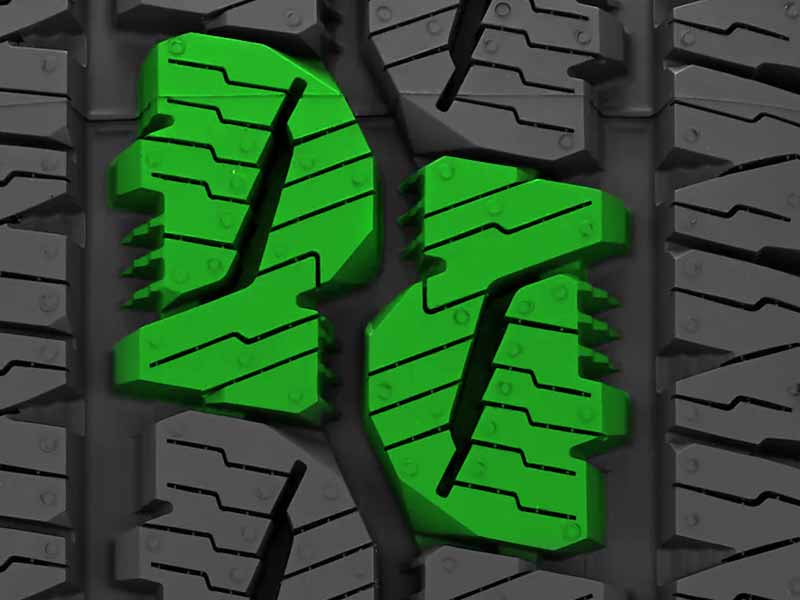
These blocks have clearly more biters in comparison, so it makes sense why this tire is superior on rocks (in terms of longitudinal grip).
But these blocks still stay stable on pavements, as they are also connected with a continuous running rib beneath.
If we move towards the shoulder blocks, again starting things with Yokohama AT, the tire offers blocks with notches facing inwards, along with full depth siping.
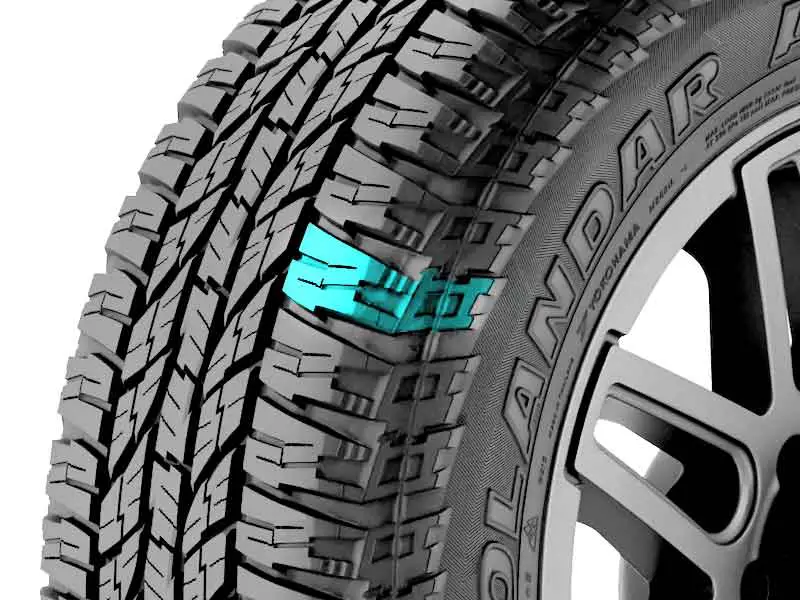
Towards outer edges, it although does not offer serrated shoulder blocks, it still has stepped edges that help in chewing off road.
These blocks extend towards the sidewalls, where the tire makes an irregular pattern, which helps when you lower the pressure down on the tire (flexing sidewalls).
On the other hand, makes bulkier shoulder blocks, with bigger traction notches and interlocking full depth sipes.
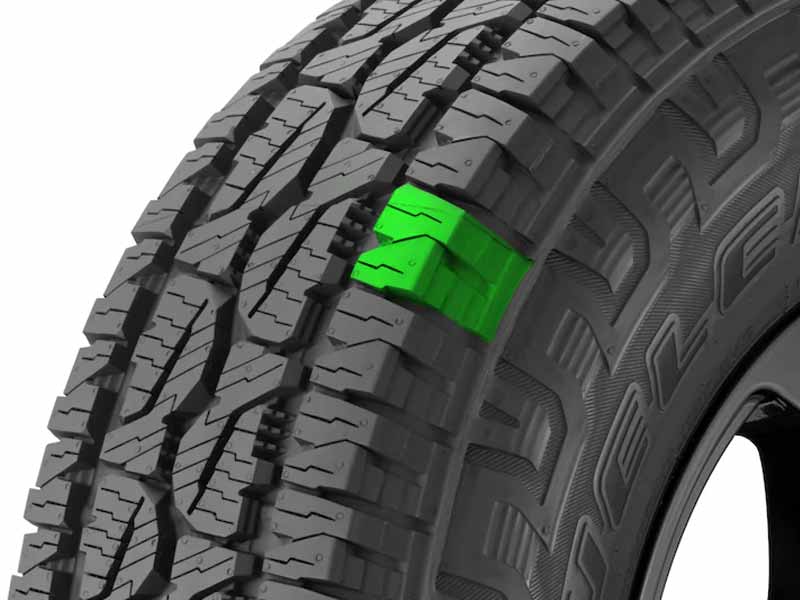
But it’s shoulder lugs are comparatively more packed together.
Towards outer edges, the tire is very similar to Geolandar G015, as all blocks are staggered on themselves, with stepped edges.
However, the tire makes larger sidewall lugs, which are pasted on a bigger surface area.
Durability
Although both tires offer you with a two-ply polyester cover, with two wide steel belts running on top.
In case of Yokohama Geolandar AT, the cap plies of nylon are spirally wound, whereas on Bridgestone Dueler AT, they just cover the central area.
So why this matters?
Well, with a spirally wound nylon reinforcements, the Yokohama G015 protects sidewalls in a better way without increasing its overall weight by a lot.
This also enhances the lateral stability on Geolandar a little bit more in comparison.
Winter Performance:
Winter performance has to do with
The Yokohama Geolandar G015 is 3 Peak Mountain Snowflake rated, which tells us that the tire is not only better here in comparison, it also offers 25% more acceleration on snow compared to average all seasons tire.
The tire offer a softer compound which does not harden up too much with freezing temperatures, and its biters everywhere grip the snow and ice in a better way.
The Bridgestone Dueler on the other hand, is stiff, so on ice the tire’s siping and notches are not that effective. That’s why they offers such a spongy compound on winter tires.
Ride Comfort:
The Yokohama Geolandar G015 is one of the most comfortable tires in the all terrain category. Moving form the passenger tire to this one, you will not feed any difference.
Comfort is actually two parts, one is tread noise and the other has to do with bumps absorption and this tire is better in both.
The Bridgestone Revo 3 on the other side, although is not too bad here,
Tread Wear:
Both tires offer similar rolling resistance values that’s why both provide you with 60k miles tread wear warranty for P metric sizes.
But Yokohama goes one step forward and also offers 50k miles warranty for LT sizes as well.
Dry Performance
When it comes to dry roads although all terrain tires aren’t as capable of performing as passenger tires, there are still some on road oriented tires that do surprisingly well, and both of our tires here are in that list.
Here the performance is analyzed by looking at the grip and handling capabilities in dry conditions with average temperatures.
Dry Grip
The dry grip of a tire has a lot to do with the rubber composition and overall structure, which includes, tire’s tread, weight and other other aspects.
So here, the Yokohama Geolandar AT G105 does not offer a better dry grip when compared. The tire simply allows less area of it’s rubber available to connect with the road, as most of that area becomes limited with several notches and wider circumferential grooves, making ribs smaller in size.
Moreover, softer rubber compounds with high silica density don’t do so good, and Geolandar offers a very spongy rubber, which does not provide as much stability, so grip gets limited.
On the other side, the Bridgestone Dueler AT Revo 3 offers fatter ribs, though the tire also makes 3 longitudinal channels.
So with fatter 2 rib design, and a stiffer compound, the tire offers a better directional stability which results in shorter braking distances (which is how grip is measured).
Dry Handling
Dry handling depends on shoulders, as they get to meet the road, the most, while cornering.
So here again, the Yokohama Geolandar AT lacks behind slightly, for two main reasons. One, it’s wider lateral grooves eat away the rubber area that would have been in contact with the surface, and two, it’s softer rubber (despite spirally wound cap ply), does not produce enough lateral stability.
On the other hand, the Bridgestone Dueler offers a more close up design with chunkier blocks so naturally more grip and lateral g forces are produced here.
Although, the overall difference between both tire’s handling time is under one second.
Wet Performance
Wet traction is a tricky subject, and here traction and hydroplaning come in to action, let’s start with traction.
Wet traction
The wet traction of the tire is dependent on the siping design and rubber composition.
With more sipes, more water gets wiped away, and with a softer composition, those sipes get to flex more, which provides better efficacy.
Basically sipes are just slits on the tire, and when the meet the water, the open and suck in the water particles by draining the air out.
Yokohama Geolandar AT is slightly better here as the tire offer more number of sipes and a soaking rubber on top, which sucks in the water particles more effectively.
In comparison the Bridgestone AT Revo 3 does not offer as much siping, and the tire is stiffer, so it naturally lacks here.
Hydroplaning
Hydroplaning is a crucial part of wet traction, and it has to do with water evacuation, the faster the water leaves, the better.
And all this depends on the tread design.
Here although both tires offer amazing straight hydroplaning resistance (moving straight on standing water), the Yokohama G015 AT offers better curved float speeds as it’s shoulder blocks have larger gaps where water can pass through.
(Curved float speed is how fast a turn can turn on water without losing traction).
Moreover, as the Geolandar AT also offers a more elastic rubber, the tread blocks flex in a way to produce negative pressure, so water is pushed out with a larger force comparatively.
Off Road Performance
Both tires are not so capable off road, though they are marketed as all terrain, that’s because their less voided tread don’t offer enough area for mud, dirt, stone, to pass through.
On mud, both tires with closed up ribs, and packed shoulder get packed very quickly.
Similarly on gravely roads, although both offer a chip resistant rubber, they are missing stone ejectors, so lodged stone can damage the tread and lose traction capabilities.
But still with lowered pressure, both tire can give you a little bit of rock climbing and sand performance.
Overall if you have to pick one for off road use, go with Yokohama Geolandar AT015, the tire is offered with more load ranges, and it’s spirally cap ply would offer more sidewall durability (which is highly needed).
Also the stickier compound of the tire gives better flexing sidewall performance as well.
To conclude
Let’s start with Yokohama Geolandar AT G105 first, this tire is 3 peak mountain snowflake rated, and it’s credited to it’s softer rubber, which although is a little prone to wear, and does not provide better dry traction, it rocks on wet, and in comfort department, and of course in snow.
The Bridgestone Dueler AT Revo 3 is a better fit for dry roads, where the tire compromises slightly on wet, but gives you a good fuel efficiency in comparison and a better dry traction.


